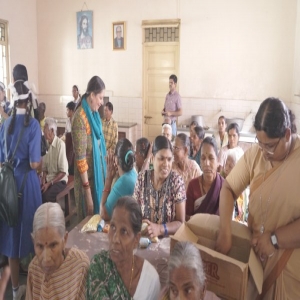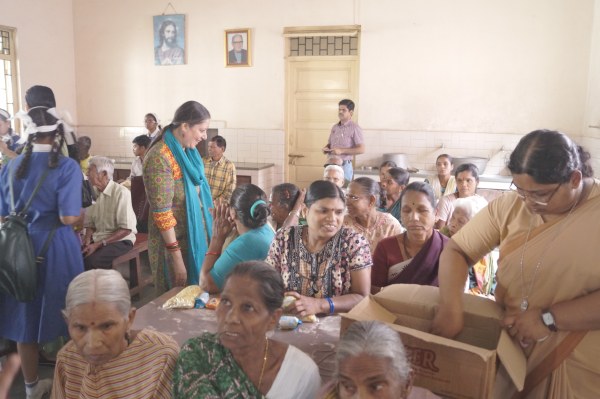

As of June 2025, we, eight Jesuits, seven Vasai Diocesan Priests, and five women from the religious sisters' communities, are involved in missionary activity at the Talasari Mission. Our deep faith and commitment inspire us to engage in dedicated acts of service for the tribals in the Talasari Mission.
Initially, the Talasari Mission was under the jurisdiction of the Archdiocese of Bombay. This was the only tribal Mission where Franciscan missionaries, Jesuits, priests from the Archdiocese of Bombay, and womens' religious congregations were actively involved in pastoral, educational, social, legal, and health ministries. The thrust of the Talasari Mission is "Empowerment of Adivasis through pastoral, social and educational efforts."
In the past, the situation was quite dire. There were no proper roads, and no transportation to reach various villages. There was stark poverty. Tribals were struggling to live their daily lives. There were no proper educational facilities, no health centre or a hospital. Tribals could not afford their basic needs. It was in this background that the Franciscan missionaries, the German and Spanish Jesuits, and missionaries from Bombay and Vasai gave their lives for the holistic development of the Adivasi people.
The History of the Mission
It was largely the German and Spanish Jesuits who worked in the Bombay Mission since 1854. The German Province sent several young Jesuits to Bombay regularly every year until 1914. During these 60 years, 366 Jesuits came to the Bombay-Poona Missions.
In May 1921, the first three Spanish fathers arrived in Bombay from Spain, and in November 1921, six more arrived from the Philippines. Many more Spaniards followed, and they worked in the Bombay Mission Region and the Gujarat Mission District. They learnt Marathi and Gujarati, the languages of the local people. Their presence and interest in people's culture made a significant difference in both missions.
These missionaries, though from distant lands, had an eagerness and an openness to embrace a new people, new languages, new cultures, new foods, new customs, and a whole new world. They set their hearts on making India, and in particular Mumbai and Gujarat, their own home.
Today, the Talasari Mission in Palghar District has a 99-year history.
In 1926, the Palghar District Mission was founded by Franciscan missionaries. It was later entrusted to the Jesuits of the Bombay Province. The Jesuits invited priests from the Archdiocese of Bombay, women religious congregations and Vasai diocesan priests. What is unique about the Talasari Mission is that the various religious communities, including fathers, sisters, brothers, and diocesan priests, work together for a common goal and share a common Pastoral Plan. Most of the local people belong to two particular tribes, the Warlis and the Kokanas, and they speak the Warli language. Since their children began studying in our primary and high schools, they have also started speaking Marathi and English.
Education Mission
The Jesuits of the Bombay Province have established a Trust to administer the Talasari Mission. It deals with education, social and development issues. The Trust, in collaboration with various Congregations of Sisters and the Diocese of Vasai, operates the following Institutions: eleven primary schools, four high schools, two junior colleges (arts and science), and five boarding schools for girls and boys.
Today, in our globalised world, English has become indispensable for progress. Currently, the Adivasis have no facilities for an English education. Those who can afford it are attending the existing English-medium schools in the area. Adivasis must have the opportunity to compete equally with their local and urban counterparts in professional careers. However, the local educational policy does not provide funding for an English education.
Pastoral – Spiritual Mission
Since 1926, the Franciscan Missionaries had been doing pastoral work among the tribal people. Later, alongside their pastoral work, the Jesuits initiated educational and social awareness projects. However, missionaries prioritised pastoral and spiritual work. The Eucharist was celebrated in different villages in people's houses. Today, entire villages (padas) have their own small chapels. There is a good response for the celebration of the Eucharist in these chapels. Many people attend RCIA classes, and after completing a year of full training, they receive baptism of their own free will.
Last year, during the inaugural Mass of a new chapel in one of the villages, Archbishop Felix Machado said that "the Church will be very useful to the mission area for the Adivasi people. It was a joyous celebration; our Adivasi brothers are Christians with solid roots and will be able to carry forward the mission of the Church. Young people who were confirmed are Christians who, I am sure, will be Catholic leaders of the future."
Today, the Church's thrust is "Education and Adivasi Empowerment through social outreach." The Archbishop said, "Health has been given priority, and the Church has started schools in every little pada. Adivasi culture has also been acknowledged, preserved and promoted," he noted. "The Church has always kept the principle of serving the least, the lost and the last, regardless of caste, creed, race or religion."
Today, the Talasari religious community has reached out to help the poor. Many sisters are involved in health work and women's empowerment. Children are also cared for, and some stay in boarding schools, attending classes at various locations.
Religious Womens' Congregation
The Canossian Sisters have houses for leprosy patients, where they care for about 50 inmates. They also have a clinic. A different doctor visits the clinic every day to treat the impoverished Adivasi patients. Many sisters and nurses are also involved in medical work.
In addition to the Canossians, the Verdun Sisters, the Fatima Sisters, the Daughters of the Cross Sisters, and the Holy Cross Sisters are also involved in social development. They run various projects under which they conduct programs for women. Children from far-off interior villages are unable to attend school due to a lack of transportation. These children live in the boarding, making it convenient for them to attend school every day.
Warlis – Adivasi Identity
Warlis clearly assert their identity as separate from other tribes and claim that they have been so called since the time of their earliest ancestors. The Warli language incorporates numerous loanwords from Sanskrit, Gujarati, Marathi, and Hindi. The Adivasi identity has been highlighted in the existing Warli way of life, art, culture, and heritage.
The agricultural season for the Warlis begins around May. With the first rains in June, the paddy seeds are planted. Then the people are busy with agriculture. From September onwards, people begin harvesting. Agriculture is their primary occupation, providing the bare essentials of sustenance to the Warlis. Rice is their chief crop, harvested once a year. The men of the family work during the summer on other farms, constructing bunds, working in brick kilns, repairing roads for the Government, or with the forest department. The women lend a helping hand by cutting grass to be sold in the market.
Adivasi Annual Magazine
The magazine "ADIVASI" (1999) is the first fruit of "Adivasi Janjagaran Ani Sanskriti Samvardhan Kendra" (The Centre for Awakening and Preserving Adivasi Art, Culture and writing). In this magazine, the sons and daughters of the Adivasis of Dahanu and Talasari Talukas studied and wrote on specific topics. The purpose was to allow their writing talents and skills to come to the forefront and to express their own cultural identity. Five "ADIVASI" magazines were published. All the new writers received proper training in writing, and they successfully achieved what they set out to do. The ADIVASI magazine serves as a stepping stone from a historical perspective in the social, cultural, educational, and economic fields of the Warli community.
Warli Painting
The Warlis of Palghar District in Maharashtra are known for their Warli paintings. They do not consist of the myriad primary colours, so intimately associated with folk painting in India. Instead, they are painted on an austere brown surface using only one colour - white. Warli Art is a beautiful folk art form of Maharashtra, created by the women of the Warli community. White is the only colour used in creating these paintings, with occasional dots in red and yellow. This colour is prepared by grinding rice into a white powder.
The impact of the missionaries on this tribe is significant. Since 1926, the tribals and Missionaries walked on less-travelled roads and journeyed more through the jungle. Today, the darkness has vanished, and light is shining in the Adivasi's life.